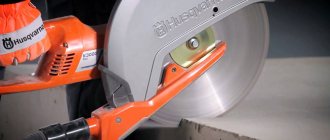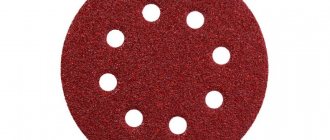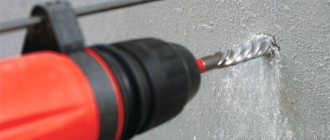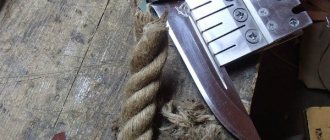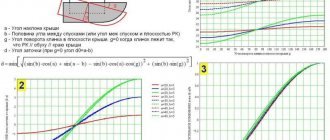The main working element of a wall chaser is a diamond disc. With the right choice, it is able to quickly, accurately and without disturbing the structure of the material being processed, make a cut in it of the required depth and length. Manufacturers of hand-held power tools and consumable parts for them offer a huge range of discs that differ in purpose, geometric dimensions, shape of cutting edges, base composition and coating. Knowledge of the basic selection criteria and marking features is an indispensable condition for the correct use of the tool.
Introduction to Diamond Cutting Wheels
Wheels with diamond cutting edges for waterless cutting were first created in the design bureaus of the Japanese company Sankyo Diamond Tools, a structural division of Hitachi Corporation.
Many technologies were used for the first time, so the wheels were not reliable enough and quickly failed. For example, diamonds and the cutting part were attached to a steel base using high-temperature soldering. During operation, when a large friction force occurred, the metal heated up, the solder melted and the working part simply fell off. With water cooling, such circles worked more or less tolerably, but with dry friction their service life was short.
The fact is that diamond does not cut the material, but abrades it into dust; high frictional forces are accompanied by rapid heating - the heat does not have time to be dissipated throughout the body of the circle, in addition, despite the presence of special slots, the circle is deformed when heated. Changes in shape are insignificant and do not threaten destruction, but have a negative effect on the strength of the connection.
Sankyo Diamond engineers also proposed other solutions - sintering the working part and the base under high pressure. This connection is more durable and can withstand significantly higher temperatures. Thus, it was possible to create segmented and solid disks that are resistant to heat and deformation. The technology is still in use today.
The second solution is laser welding at the molecular level. This technology produces only segmented circles. In terms of strength and reliability, both types of discs are almost the same, although many professionals believe that those made by laser welding are better.
Working principle of diamond cutting disc
Most diamond blades are used on angle grinders with speeds up to 12,000 rpm. The maximum number of revolutions that the best wheels can withstand is 13900 rpm, but there are not too many tools capable of developing them when cutting.
Only the diamond itself comes into contact with the surface being treated - it protrudes above the surface of the rim and, when rotated, abrades the material into fine dust. The multi-layer structure of the cutting edge ensures that the disc is always ready for work - diamonds that have worn out or flown out of the socket are replaced by others that are located in a lower layer of the rim.
Excess heat is dissipated through the disk body, but, nevertheless, it heats up to fairly high temperatures, which requires compliance with certain safety rules when dry cutting.
The durability of the wheel and the effectiveness of its use depend on the size of the diamonds. Large ones provide efficient operation, but wear out quickly, small ones cut very accurately, but more slowly, their service life is 25 - 30% longer than that of tools with large crystal fractions.
Design of diamond cutting discs
Structurally, a diamond disk is a steel circle with a cutting part and slots over the entire area, which facilitate heat removal and reduce deformation stress. Diamonds are interspersed throughout the rim of the disc. They are inserted into a rim made of nickel, zinc, cobalt and tin alloys. With a linear speed of up to 80 m/s and enormous frictional forces, the fastening must be extremely strong, which is achieved using special technologies.
To ensure that the cutting part is held under heavy loads, they can be secured by laser welding, sintering, electroplating or soldering. Soldering is only used on cutting discs using water-cooled machines.
Depending on the method of securing the diamond, the purpose of the disc is determined. Galvanically fixed diamonds are designed to work with soft types of natural stone, processed by laser welding and sintering, especially segmented ones - for all types of hard materials in a dry and “wet” method.
The holes and slots are located strictly symmetrically, and the mass of diamonds is also balanced in diametrically opposite directions. This eliminates vibration and “beating” of the disk and ensures uniform cutting. But you can use dry cutting wheels only to make a straight cut - with a curved trajectory, the disc can not only lose diamonds, but also be destroyed. This type of instrument is very sensitive to lateral loads.
1. Damping slots. 2. Cutting layer. 3. Mounting hole. 4. Steel disk.
Design features and scope of application of manual wall chasers
It is not always necessary to groove hard surfaces. Very popular materials in modern construction are aerated concrete and foam concrete. The structures are quite soft; there is no need to use expensive and powerful power tools to work on them. The best wall chaser in such situations, in terms of practicality, is a manual one.
For gating aerated concrete and foam concrete, it is enough to use a manual wall chaser
The device is inexpensive and easy to use. The tool consists of a metal pipe, an arc welded to it, which is used for cutting, and two handles. More expensive models have diamond tips on the cutting part.
There are two types of manual furrowers:
- for working on vertical surfaces;
- for gating horizontal planes.
There are no fundamental differences between these two types. The pipe is bent slightly differently and the handles are located. Design features contribute to optimal load distribution during tool operation.
The sequence of work with a manual wall chaser can be as follows:
- Markings must be applied to the surface.
- Grab the pressing handle with your right hand, and the remote handle with your left.
- Bring the cutting element tightly to the wall.
- While pressing with your right hand, gradually move the wall chaser with your left.
There are two types of manual wall chasers: for working in vertical and horizontal planes
Helpful advice! If there is a small amount of work to be done and the purchase is not justified, you can make a manual wall chaser yourself.
Types of diamond blades
Diamond cutting discs have certain differences in design and manufacturing technology.
Types of diamond discs by structure
According to their structure, dry cutting discs are divided into:
- solid;
- segmented;
- turbo;
- turbo segmented.
Solid diamond discs. They are equipped with a continuous cutting belt running along the circumference, into which artificial diamonds are embedded in several rows. For cutting ceramics and other materials where cutting accuracy is the main parameter, wheels with a solid edge are preferable.
Segmented diamond blades. Segmented ones are divided by radial slots into several working sections of the same size; they are more resistant to mechanical and temperature loads and are used more often than solid ones, although they are somewhat more expensive. They are more productive than solid ones, but the cut after them is not as accurate. They are best used for rough cutting of concrete structures.
Diamond turbo discs. Turbo discs are distinguished by the presence of oblique (and other) notches on the sides of the rim. It slightly increases the mechanical strength of the wheel and significantly enhances the intensity of heat removal, which allows you to speed up cutting from 50 to 100%. Like segmented discs, turbos are suitable for fast cutting of any mineral materials with a wide range of hardness - from sandstone to concrete and granite.
Turbo segmented diamond blades. Wheels divided into segments with a side notch “turbo” are even more productive. They are characterized by high performance and versatility.
Disc differences based on diamond arrangement
Artificial diamonds are fixed in the working rim in a certain order. There are circles with an even distribution when any of the selected units of length or segment contains the same number of crystals.
But there are also circles in which diamonds are arranged with a certain period (the so-called sandwich circles). They are more productive, providing less force on the tool, more efficient cooling and even distribution of force.
Diamond blades for dry and wet cutting
According to the cutting method, diamond discs are divided into wheels for dry and wet cutting. The former provide an accurate cut and are cleaner to work with, but require the use of dust extraction devices - when cutting, very small particles of solid materials are formed that irritate the eyes and respiratory tract. Water-cooled wheels operate with a constant flow of liquid, which binds and washes away dust, but they cannot always be used. This is due to some cumbersomeness of the hydraulic system and the formation of drips.
Dry cutting wheels can be used in water-cooled machines, but wet cutting wheels cannot be used without cooling - they overheat and quickly break down.
The Best Single Disc Instruments
The advantage of this type of wall chaser is its versatility. The furrower makes a straight hole in the concrete and, when changing the cutting disc, turns into a classic angle grinder or cutting machine. This type of tool is beneficial for occasional use as a wall chaser. It differs from a regular grinder in the design of its casing and the ability to make depth-adjustable cuts in solid concrete.
Diamond saw PIT P41103 - the most inexpensive
An inexpensive single-disc wall chaser is used to make grooves in solid concrete structures and masonry. The depth of the cut allows you to hide cable networks and common sizes of pipes used inside residential and civil buildings. Replacing the diamond disc with another processing accessory turns the tool into an angle grinder with classic functionality.
- Great price.
- Combining two-in-one functions.
- Compact sizes.
Interskol OM-115/1300 – visual inspection
The machine is designed as a compact portable machine. The tool combines two functions - forming grooves and cutting various materials: tiles, tiles. Installing another cutting tool allows you to cut metal. The furrower is equipped with a stable flat sole and a rubberized handle - this increases the accuracy of operations and allows you to visually control the work process.
- Multifunctionality.
- Easy to use.
- Works great on horizontal surfaces.
- There is no possibility to connect a vacuum cleaner.
- Small saw blade size.
- Using an adapter to fix the disk.
RedVerg RD-WG40 – the optimal choice
A classic furrow saw that cuts grooves in concrete and stone-like materials. Allows you to select for window and door frames. The emission of dust during the working process is stopped by connecting an industrial vacuum cleaner. The reliability of the tool is enhanced by built-in overload protection. The "Soft start" function is provided.
- Optimal power.
- Starts without any sudden impact thanks to soft start.
- It is possible to equip with additional disks.
- A little heavy for working on vertical surfaces.
Hitachi CM 9UBY - the most powerful
Thanks to its powerful motor, the furrower is used for construction and finishing work. It is used to carry out hidden wiring of cable networks and water supply pipes. The design provides an effective system of protection against overheating of the engine and other components. The cleanliness of the working area is ensured by dust extraction.
- Great power.
- High quality build.
- Convenient case for carrying and storage.
- There is no speed control function.
Festool Diamant DSC-AG 125 FH Plus – the lightest
The cutting system combines several functions: it cuts expansion grooves in a concrete floor screed, makes recesses for hidden installation of communication systems, and makes cuts in the mass of brickwork for windows and doors. Low weight allows you to perform work on vertical and ceiling structures. Speed adjustment and “Soft start” are provided.
- Easy.
- Smooth entry into work.
- Selecting the optimal cutting mode by setting the required number of revolutions.
Makita 4112HS – largest disc diameter
The cutting saw, thanks to the increased diameter of the disc, allows you to make deep grooves for hidden wiring and water supply pipes. The engine power overcomes the resistance of all types of concrete, stone and brickwork. The possibility of smooth start-up and implementation of the work process in shock-free mode is provided.
- Large disc diameter.
- Shockless operation mode.
- Possibility of adjusting the cutting depth.
- There is no way to regulate the engine speed.
- Heavy for working on vertical surfaces.
How to choose a diamond blade for an angle grinder
When selecting a diamond blade, you need to pay attention to the type of material for which the disk is intended, its size, bore diameter and rotation speed of the disk.
Material to be worked with
Most diamond wheels are designed to work on non-metallic materials. They are most often used for cutting concrete, ceramics, glass, brick and asphalt. But there are a number of blades designed to cut metals of varying hardness. When purchasing, remember that different types of diamond blades are designed to work with different materials. There are discs designed to work with concrete, ceramic tiles, marble, granite, sandstone, stone and asphalt.
There is a certain rule for choosing a disc - for soft materials, discs with a hard diamond surround are selected, and for hard materials, with a soft one. This is determined by the degree of wear of the artificial diamonds located on the rim of the circle.
When cutting hard materials, they wear out faster and the next ones take their place from a fairly soft cutting strip. Soft materials have little effect on diamond; it must remain in its place for as long as possible, which is ensured by the solid substance in which the mineral is embedded.
In addition, different artificial diamonds are used for different wheels.
Two types of diamonds are produced industrially:
- Monocrystalline, representing one spatial structure of regular shape;
- Polycrystalline, consisting of several smaller single crystals tightly interconnected.
The former are very durable and are used for cutting hard materials and metals, the latter can be destroyed upon contact with them, therefore they are used on cheaper tools designed for relatively soft materials.
Diamond blade sizes
The maximum depth of cut and, in some cases, the speed of work depend on the size of the disc. The main diameters are 115, 125, 180 and 230 mm, which corresponds to abrasive wheels for angle grinders of the most common brands. Diamond blades with a diameter of 150, 300 and more millimeters can also be found on sale. Large diameters are installed on powerful cutting machines - gas cutters, stationary cutting machines, etc.
The most common disk mounting holes can be 22.2 mm or 25.4 mm. Buy only the size blade for which your tool is designed.
Never install a large blade on a grinder that is designed to work with a smaller blade without first removing the protective cover. This is very dangerous, since if the metal disk breaks, you can cause fatal damage to your health. If you have such ideas, then find on the Internet photos of the consequences of working with a diamond blade without a protective casing and you will forever stop wanting to work without protection.
Disk rotation speed
The maximum rotation speed and linear speed are also indicated on the discs. If the capabilities of your tool exceed the characteristics of the disk, then you cannot install it - centrifugal forces will simply tear it apart.
What are the options?
Thanks to such designs, you can cut all kinds of building materials: stone, concrete, brick, tiles, marble, asphalt and much more. Main advantages of the tool:
- accuracy;
- speed;
- noiselessness;
- productivity;
- efficiency.
They differ from each other in different cutting edges, and therefore are used in various fields of activity.
The main classification is shown in the comparison table:
| Kinds | Description |
| Segmented | Designed for dry cutting. Quickly copes with brick, granite, concrete, stone. Thanks to the segments, the product is cooled during the cutting process, reducing heat and extending its service life. The recommendations of experts boil down to the following: the continuous duration of work with it should not exceed one and a half minutes. Afterwards you have to cool it at idle for 25 - 30 seconds. |
| Solid | The main purpose is cutting marble and tiles. It involves a forced supply of water, which makes it possible to carry out high-quality cooling. The solid design allows you to cut hard material smoothly and without chips. There are no restrictions on the duration of operation. |
| Combined | Universal option, suitable for dry cutting and water supply. Cuts concrete, porcelain tiles, marble, granite, stone. In terms of functionality, it is slightly inferior to specialized analogues. |
The best manufacturers have launched the production of special wheels for cutting reinforced concrete, glass, and so on. The list of functions is usually indicated on the packaging. Subject to all operating conditions, the product will last for quite a long time.
Diamond cutting wheels vary in diameter, which ranges from 11.5 to 40 cm. In this case:
- Small (12.5 - 15.5 cm) and medium (15 - 23 cm) are used for angle grinders. The thickness of the diamond layer is 2.2 mm.
- A circle with a diameter of 35 to 40 cm is intended for use on special equipment.
Professional advice boils down to the fact that it is best to model tiles using an electric tile cutter. This device belongs to the special category. During operation, water is constantly supplied, which makes it possible to make the edge smooth and without chips. When repairing a residential building or small technical buildings, you can resort to using a grinder of low power, which is convenient to hold in your hands.
Diamond wheels are also divided into:
- professional;
- simple.
Tools differ in price. If the average cost of a simple disk with a diameter of 23 cm is 550 rubles, then the professional option will cost 2,500 rubles. For household purposes, it is worth purchasing an inexpensive, high-quality product that will be enough to get the job done. If you plan to carry out cutting on an industrial scale, then you need to pay attention to the best branded tools. Such popular models cannot be budget-friendly.




